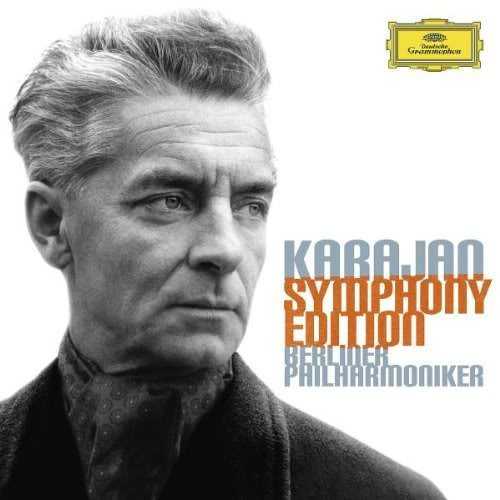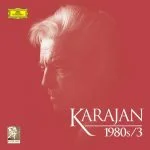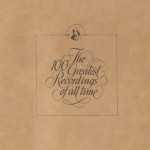
Composer: Ludwig van Beethoven, Johannes Brahms, Anton Bruckner, Joseph Haydn, Felix Mendelssohn, Wolfgang Amadeus Mozart, Robert Schumann, Peter Tchaikovsky
Performer: Agnes Baltsa, Peter Schreier, Anna Tomowa-Sintow, José Van Dam
Orchestra: Berlin Philharmonic Orchestra, Vienna Singverein, Vienna Philharmonic Orchestra
Conductor: Herbert von Karajan
Audio CD
Number of Discs: 38 CD box set
Format: FLAC (tracks+cue)
Label: Deutsche Grammophon
Size: 10.6 GB
Recovery: +3%
Scan: yes
Vol.01 CD 01-06 Ludwig van Beethoven: Symphonies 1–9; 6 Overtures
Vol.02 CD 07-09 Johannes Brahms: Symphonies 1–4; Tragic Overture and Haydn Variations
Vol.03 CD 10-18 Anton Bruckner: Symphonies 1–9
Vol.04 CD 19-25 Joseph Haydn: “Paris” & “London” Symphonies
Vol.05 CD 26-28 Felix Mendelssohn: Symphonies 1–5
Vol.06 CD 29-31 Wolfgang Amadeus Mozart: Late Symphonies (nos. 35–41) and nos. 29, 32 & 33
Vol.07 CD 32-34 Robert Schumann: Symphonies 1–4; Overture, Scherzo and Finale Fourth Symphony
Vol.08 CD 35-38 Peter Tchaikovsky: Symphonies 1–6
karajan_symphony_edition02.rar – 276.7 MB
karajan_symphony_edition03.rar – 254.2 MB
karajan_symphony_edition04.rar – 264.4 MB
karajan_symphony_edition05.rar – 265.1 MB
karajan_symphony_edition06.rar – 293.9 MB
karajan_symphony_edition07.rar – 345.3 MB
karajan_symphony_edition08.rar – 361.1 MB
karajan_symphony_edition09.rar – 147.4 MB
karajan_symphony_edition10.rar – 327.5 MB
karajan_symphony_edition11.rar – 253.2 MB
karajan_symphony_edition12.rar – 259.9 MB
karajan_symphony_edition13.rar – 331.2 MB
karajan_symphony_edition14.rar – 277.6 MB
karajan_symphony_edition15.rar – 257.9 MB
karajan_symphony_edition16.rar – 233.3 MB
karajan_symphony_edition17.rar – 270.4 MB
karajan_symphony_edition18.rar – 249.9 MB
karajan_symphony_edition19.rar – 354.9 MB
karajan_symphony_edition20.rar – 365.9 MB
karajan_symphony_edition21.rar – 337.7 MB
karajan_symphony_edition22.rar – 352.6 MB
karajan_symphony_edition23.rar – 293.6 MB
karajan_symphony_edition24.rar – 275.9 MB
karajan_symphony_edition25.rar – 300.7 MB
karajan_symphony_edition26.rar – 291.5 MB
karajan_symphony_edition27.rar – 328.4 MB
karajan_symphony_edition28.rar – 334.2 MB
karajan_symphony_edition29.rar – 338.6 MB
karajan_symphony_edition30.rar – 315.6 MB
karajan_symphony_edition31.rar – 267.0 MB
karajan_symphony_edition32.rar – 313.0 MB
karajan_symphony_edition33.rar – 321.2 MB
karajan_symphony_edition34.rar – 223.7 MB
karajan_symphony_edition35.rar – 309.4 MB
karajan_symphony_edition36.rar – 332.2 MB
karajan_symphony_edition37.rar – 320.9 MB
karajan_symphony_edition38.rar – 296.5 MB
Getting to know Karajan’s legacy? Begin here.
Admirers of Karajan will probably own most or all of these symphony cycles from what was probably the pinnacle of the conductor’s prolific career. However, if you are unfamiliar with Karajan’s work, or well enough acquainted with it to desire further exploration, then this amazingly inexpensive anthology can be enthusiastically recommended. I purchased all of these sets when they came out in DG’s previous mid-priced “Karajan Symphony Edition,” and I can testify to their consistently oustanding quality, both as performances and as interpretations. As recordings, however, it must be admitted that the sound is of variable quality; sometimes admirably vivid and well balanced, but frequently tending toward harshness, even garishness–particularly in those which come from the early digital era (cf. Bruckner’s symphonies 1-3). Too bad Universal didn’t see fit to give this magnificent legacy a sonic facelift. Still, the performances are sufficiently worthy of your attention to warrant purchase regardless of these sonic limitations.
Here is a brief rundown of the symphony cycles included in this box:
1. Haydn “Paris” and “London” symphonies (nos. 82-87 and 93-104): We don’t usually think of Karajan as a great Haydn interpreter, but the evidence belies that impression. His recorded legacy contains quite a lot of the composer’s music including these two symphony sets, two versions of *Creation* (DG), *The Seasons* (EMI) plus some miscellaneous symphonies (82, 83, 104, also for EMI). The Haydn symphonies included in this box are, to be sure, given the “big band” treatment; nevertheless, they have a spring to their step as well as a warmth and, where appropriate, a dramatic urgency, which mostly keeps them from sounding turgid or languid. Karajan generally favors upbeat tempos and though, as we might expect, textures are blended and phrasing smooth, Haydn’s wit and sparkle survive intact. Only the slow and stately Menuettos might prove controversial, though many modern-orchestra conductors, such as Bernstein, Dorati and Solti favor a similar approach to these movements. In the end, Karajan would not be my first choice in this repertoire: I prefer the earthier Bernstein in the Paris group and the leaner, more vibrant Solti in the London. But Karajan’s Haydn is not to be dismissed; he brings a combination of majesty and elegance which is often surprisingly convincing.
Mozart Symphonies (33, 35-41): I am less enamored of Karajan’s Mozart than his Haydn. The conductor was at his best in Mozart in his younger days; his finest batch of Mozart symphonies come from Vienna and the Philharmonia in the 1950’s (check out EMI’s omnibus Karajan edition for these). Those earlier performances have a vitality and leanness of texture which the DG performances from the 1970’s lack. On the other hand, it is possible to enjoy, even revel in, the glorious sounds of the BPO while disregarding the overly sleek, and sometimes bloated, textures Karajan evoked in later years. Again, not a first choice in this repertoire (I prefer Beecham, Klemperer, Walter and Szell), but worth hearing.
Beethoven Symphonies 1-9 and Selected Overtures: DG have given us the 1977 cycle here, not the better-known and more commonly recommended cycle from the early Sixties. In all, Karajan gave us four Beethoven Symphony cycles: One for EMI (with the Philharmonia, in Mono), and three for DG (one from each decade after 1960). He also recorded miscellaneous Beethoven symphonies in Vienna during the late ’40’s. In general, I prefer his earliest efforts in Beethoven, which have a clarity and incisiveness Karajan would only intermittently realize in his two stereo and one digital Beethoven cycles. Yet there is no denying that the 1977 cycle is an remarkable accomplishment. In many ways the interpretations seem fresher and more spontaneous than those from the early ’60’s. In 1977, the *Eroica* blazes fiercely at somewhat hectic speeds in the outer movements and the Ninth is nothing short of overwhelming in its elemental power. The Sixth is definitely more congenial in 1977; the earlier Berlin version sounded uncomfortably rigid and businesslike, at very brisk tempos. Otherwise, there’s not much difference between the two Stereo cycles, except that the interpretations in 1963 seem less focused, or fully formed, than in 1977.
Schumann Symphonies 1-4: If you were introduced to Schumann’s chimerical muse through Bernstein’s classic set of the four symphonies, Karajan may strike you as too level-headed, even stuffy. He certainly doesn’t convey the manic-depressive qualities in Schumann’s music as effectively as Bernstein. On the other hand, Karajan does convey a breadth and almost Brucknerian majesty in no. 2 that is quite unique. A glorious performance. The Fourth is also superlative–the only version that can seriously rival Furtwängler’s classic account for its control of tempo, transition and texture. The “Spring” and “Rhenish” are also very fine: sumptuously played, beautifully crafted, intelligently structured–but wanting in spontaneity.
Mendelssohn Symphonies 1-5: A surprise, perhaps, that Karajan should prove such a sympathetic Mendelssohn interpreter, but so it is. This is, in my estimation, the most involving Mendelssohn cycle ever recorded; it easily surpasses Abbado, Dohnanyi, and Sawallisch (among those cycles with which I am familiar). Karajan evokes playing from the BPO that is little short of glorious in all five symphonies. His tempos seem just right (not too breathless in the Scottish and the Italian) and his strong advocacy of the two lesser-known works (the early c-minor, no. 1, and the once-popular *Lobgesang*, no 2) may convince you that their relative neglect is unwarranted. The *Lobgesang* in particular is given an affectionate, expansive, and–in the Choral finale–exultant reading that makes it a prime recommendation for this work. Only the “Reformation” disappoints on account of its rather inflated rhetoric–though no more so, perhaps, than many other versions.
Brahms symphonies 1-4, plus Tragic Overture and Haydn Variations: Brahms was one of Karajan’s specialties; he recorded at least four complete cycles plus numerous miscellaneous versions of particular symphonies at different times in his career. The cycle included here probably represents his most mature thoughts on a composer for whom he had a particular affinity. These are warm, yet dramatically compelling accounts, in which every detail takes its place within a clearly-articulated structure. The same goes for the Haydn Variations and Tragic Overture. If, in the end, Furtwängler, Klemperer and Walter brought special insights to these works that Karajan’s more generalized interpretations cannot match, Karajan is certainly leagues ahead of the many faceless or tendentious Brahms cycles that have come our way since the 1970’s. A strong recommendation, then, even though one might want to supplement these recordings with those by the conductors listed above.
Bruckner Symphonies 1-9: For a more complete exposition, see my Amazon.com review of this classic Bruckner cycle for the older “Karajan Edition.” Suffice it to say here that Karajan was one of the half-dozen greatest interpreters of this composer. His Bruckner tends toward the Olympian in its loftiness, grandeur and spaciousness. Though by no means chilly, Karajan’s take on this composer is neither intimate nor humane, but rather stresses the sublimity, even the remoteness, of these vast symphonic mountain-peaks. He is at his best in 1, 4, 5, 7-9. The others offer superb playing, but are either subverted by strident early-digital recording (particularly atrocious in the case of no. 3), or compromised by a less than fully sympathetic interpretation (2 and 6).
Tchaikovsky Symphonies 1-6: Karajan recorded Symphonies 4, 5 and 6 so many times one loses track of them all! If nothing else, this proliferation of recordings indicates that Karajan took the composer seriously; not for him a condescending attitude toward Tchaikovsky! Among his many versions of the Final Three (and I have heard most of them), my preference would be for those with the BPO from the 1960’s (one traversal for EMI, another for DG, as I recall). Karajan peaked as a Tchaikovsky interpreter during that decade; thereafter a certain staleness crept into his renditions of 4-6, for all their rhetorical power. On the other hand, Karajan’s only recording of the three early symphonies, also included in this complete set, represent a fresh encounter with the music, and for this reason they sound as vital and atmospheric as one could wish. Indeed, these are among the very best versions available of the “Winter Dreams, “Little Russian” and “Polish” symphonies. Some critics have found them more “Teutonic” than “Slavic,” but I tend to disagree. If by “Slavic” one means “prone to emotional extremes, darkly brooding and effusively sentimental”; and if by “Teutonic” one means “given to rigor, order, and discipline”; then the foregoing assessment is based on cultural stereotypes not responsible criticism. In fact, Karajan’s renditions of these early symphonies are both emotionally charged and intellectually rigorous; an ideal combination, in my estimation, and one that reveals Tchaikovsky as a master symphonist even at this relatively early stage in his career.
In sum, then, this massive box provides a superb survey of Karajan’s genius at full stretch, warts and all. The recordings do not always fall pleasantly on the ear, but the BPO’s collective virtuosity, beyond praise, amply compensates for sonic limitations. And the price is definitely right. What are you waiting for?




thanks for your affords for bringing us these lots of hard to find cd sets. On disc 5 track 07 is in .fla format and it’ s corrupted so can you decode track07 again? thanx
add the c to get the correct suffix. the track works well
Thank you very much!
thanks!
Thank you for this also. But I can’t find the scans?
Gracias
Thank you!
Again, like the Great Composers, or the Steinberg Collection, another so expensive otherwise boxset, just for grabs. thanks so much – I have to wait for tomorrow the 1st of the month so I can download again (my limit was reached) – there is a foreign download limit in Iceland! Hope the links will stay alive! :razz:
Many thanks for this. Again, it fills in some gaps.